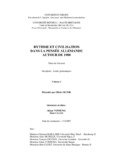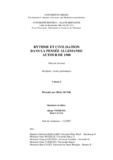Citation link:
https://nbn-resolving.org/urn:nbn:de:hbz:467-3271| DC Field | Value | Language |
|---|---|---|
| dc.contributor.author | Hanse, Olivier | - |
| dc.date.accessioned | 2019-09-02T09:56:43Z | - |
| dc.date.available | 2008-03-12T12:12:12Z | - |
| dc.date.available | 2019-09-02T09:56:43Z | - |
| dc.date.issued | 2007 | - |
| dc.description | Diese Hochschulschrift wurde an der Universität Siegen und an der Universität Rennes als Dissertation angenommen. | de |
| dc.description.abstract | Autour de 1900 en Allemagne, l’ « arythmie » des individus est présentée par un certain nombre d’auteurs comme le symptôme d’une civilisation malade, qu’il faut à tout prix sauver du déclin. La disparition du rythme, constatée dans un grand nombre de disciplines, semble par ailleurs accuser le triomphe d’une vision matérialiste et « microscopique » du monde, qui rend l’homme aveugle aux miracles du vivant, tandis que dans les écoles et dans les universités s’impose un modèle de formation utilitariste, qui privilégie les savoirs techniques au détriment de l’intuition, de l’esprit de synthèse et de la créativité. Parallèlement à ce diagnostic, le même concept de rythme, que l’on suppose avoir joué, à l’origine, un grand rôle dans la socialisation de l’être humain et dans le développement de la culture, se retrouve au centre de projets utopiques fondés sur la gymnastique et la danse, qui visent à retransformer un corps social « mécanisé » et « disloqué » en une communauté saine et fraternelle. Par-delà les conflits de terminologie et de méthode qui opposent les différents représentants du « mouvement du rythme », cette étude tente d’éclairer les motivations individuelles et collectives de ce discours, de faire ressortir les mécanismes psychosociaux qui le traversent, ainsi que les causes de son succès, tout en le replaçant dans le contexte historique, social et culturel qui lui a donné naissance. | fr |
| dc.description.abstract | Around 1900 in Germany, people’s “arrhythmia” was presented by a certain number of authors as the symptom of a sick civilisation that absolutely needed to be saved from decline. The disappearance of rhythm observed in a large number of fields seemed moreover to affirm the triumph of a materialistic and “microscopic” vision of the world which blinded man to the miracles of life, while in schools and universities a model of utilitarian tuition was being asserted that favoured technical knowledge to the prejudice of intuition, sense of synthesis and creativity. Concurrently to this diagnosis, the same conception of rhythm that is supposed to have initially played a great role in the socialization of mankind and in the development of culture, is to be found at the heart of utopian undertakings based on gymnastics and dance aimed at retransforming a “mechanised” and “dislocated” social body into a healthy and fraternal community. Beyond conflicts of terminology and method opposing different representatives of the “rhythm movement”, this study endeavours to enlighten individual and collective motivations of this discourse, to bring out the psychosocial mechanisms that traverse it, as well as the reasons for its success, while repositioning it in the historical, social and cultural context that engendered it. | en |
| dc.identifier.uri | https://dspace.ub.uni-siegen.de/handle/ubsi/327 | - |
| dc.identifier.urn | urn:nbn:de:hbz:467-3271 | - |
| dc.language.iso | fr | fr |
| dc.rights.uri | https://dspace.ub.uni-siegen.de/static/license.txt | de |
| dc.subject.ddc | 943 Geschichte Deutschlands | de |
| dc.subject.other | philosophy of life | en |
| dc.subject.other | life-reform movement | en |
| dc.subject.other | cultural critic | en |
| dc.subject.swb | Kulturkritik | de |
| dc.subject.swb | Lebensreform | de |
| dc.subject.swb | Lebensphilosophie | de |
| dc.title | Rythme et civilisation dans la pensée allemande autour de 1900 | fr |
| dc.title | Rhythmus und Zivilisation um 1900 | de |
| dc.title.alternative | Rythm and civilization in German thought around 1900 | en |
| dc.type | Doctoral Thesis | de |
| item.fulltext | With Fulltext | - |
| ubsi.date.accepted | 2007-11-30 | - |
| ubsi.publication.affiliation | Fachbereich 3, Sprach-, Literatur- und Medienwissenschaften | de |
| ubsi.subject.ghbs | AFI | - |
| ubsi.type.version | publishedVersion | de |
| Appears in Collections: | Hochschulschriften | |
Files in This Item:
| File | Description | Size | Format | |
|---|---|---|---|---|
| hanse_vol1.pdf | 1.44 MB | Adobe PDF |  View/Open | |
| hanse_vol2.pdf | 1.35 MB | Adobe PDF |  View/Open |
This item is protected by original copyright |
Page view(s)
522
checked on Nov 25, 2024
Download(s)
1,415
checked on Nov 25, 2024
Google ScholarTM
Check
Items in DSpace are protected by copyright, with all rights reserved, unless otherwise indicated.

